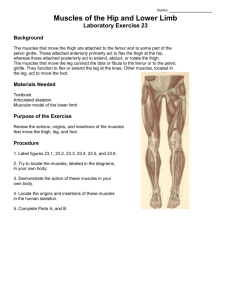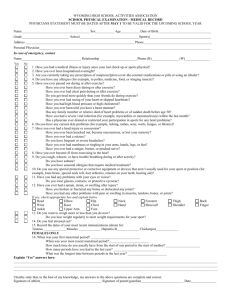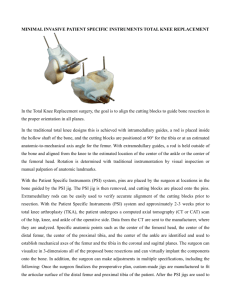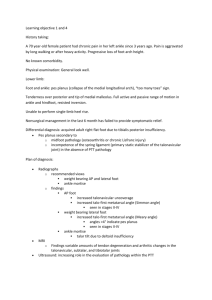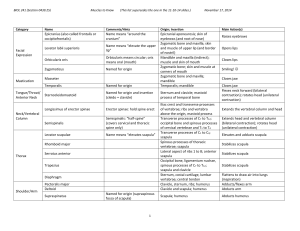Personal Fitness Anatomy Notes (Student Copy)
advertisement
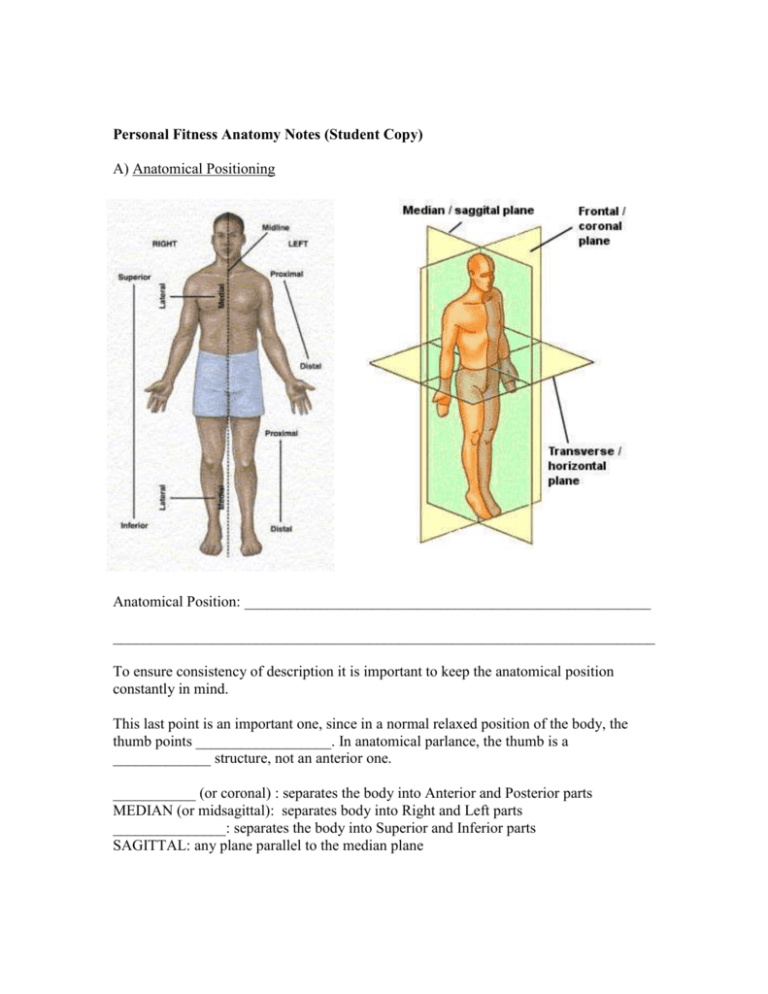
Personal Fitness Anatomy Notes (Student Copy) A) Anatomical Positioning Anatomical Position: ______________________________________________________ ________________________________________________________________________ To ensure consistency of description it is important to keep the anatomical position constantly in mind. This last point is an important one, since in a normal relaxed position of the body, the thumb points __________________. In anatomical parlance, the thumb is a _____________ structure, not an anterior one. ___________ (or coronal) : separates the body into Anterior and Posterior parts MEDIAN (or midsagittal): separates body into Right and Left parts _______________: separates the body into Superior and Inferior parts SAGITTAL: any plane parallel to the median plane Movement Definition Flexion Increasing joint angle in saggital plane (straightening elbows) Hyperextension Abduction Returning a body part to body midline (in frontal plane) Turning a body part on axis (horizontal plane) (not rotation all the way round - see circumduction). Lateral flexion Bending body sideways (frontal plane) Lateral extension Elevation Lifting a body part (shoulder shrugs) Lowering a body part (dropping the jaw) Protraction Bringing a body part back Pronation Rotating Palm Forward (anatomical position) Bending ankle so that the toes are raised Hyperextending ankle joint so toes point downwards Range of movements that create a complete circle (as opposed to a rotation of less than 360 degrees.) Posterior Backside of coronal plane Anterior Front Side of coronal plane Superficial Near surface of skin B) Anatomy and Physiology of Foot and Ankle a) Bones of the Foot i) Toes: _______________________________ - Most ____________ portion of the foot - Similar to fingers in the hand but serve much different purposes - Gives the body a wider base for: - First toe (Big Toe) is called the ________ and has two phalanges - The rest of the toes have _____ phalanges and are numbered 2-5 continuing lateral from the Hallux. ii) _____________________: The base skeletal frame of the foot. - ___ bones located between the phalanges and the Tarsals - Little movement allowed in the metatarsals however there is a _____________________________which gives the region elasticity for weight bearing - ___________________________ joints permit the hinge action between the metatarsals and the phalanges. iii) ____________: The “Ankle” Bones, seven bones between the metatarsals and the Tibia and Fibula. - __________________: The largest tarsal bone - Supports the Talus and creates your heel - Main Functions are: - ____________: The most superior of all the Tarsals - Uppermost part of the bone is called the ___________ and it articulates with the _____________ Malleoli of the ____________ and the _______________ Malleoli of the ________________ to create the true ankle joint.. - The tibia rests on this and is broader anteriorly preventing the tibia from slipping forward during locomotion - _________________: Positioned anteriorly to the talus on the medial side of the foot. It articulates anteriorly with 3 cuneiform bones. - ______________: Positioned on the lateral aspect of the foot. Articulates posteriorly with the calcaneus and anteriorly with the fourth and fifth metatarsals. - __________________: 3 bones located between the Navicular and the base of the first three metatarsals on the medial aspect of the foot. - Main purpose of the Navicular, Cuboid and the three cuneiforms is added stability in the foot and ankle and an attachment point for ligaments. b) Arches of the foot: Arches assist the foot in _________________ the body weight; in ____________ the shock of weight bearing and in ________________ on the plantar aspect of the foot for blood vessels, nerves and muscles. There are four arches in the foot: i) _____________________________ - Shaped by the distal heads of the metatarsals. - Has a semiovoid appearance, stretching from _____ to _________ metatarsal. ii) _____________________ - Extends across the transverse tarsal bones, cuboid and cuneiforms, forms a half dome. iii) ___________________________________ - originates along the medial aspect of the calcaneus and extends forward to the distal head of the first metatarsal. - Bony support is provided by the calcaneus, talus, navicular, first cuneiform and first metatarsal. - ____________________________________ is the main ligament support for this arch. iv) ________________________________________ - On the outer aspect of the foot, follows the same pattern as the medial longitudinal arch. - Formed by the calcaneus, cuboid, and fifth metatarsal bones. - ___________ and ____________ than the medial longitudinal arch. c) ______________________: Supports and separates muscle in the plantar aspect of the foot. - Thick white band of fibrous tissue originating from the medial tuberosity of the calcaneus and ending at the proximal heads of the metatarsals. - Supports the foot against downward forces much like the ligaments of the foot C) Anatomy of the Lower Leg and Ankle a) The lower leg is located between the knee and the ankle and contains two bones, multiple muscles, blood vessels and nerves. b) Bones of the Ankle and Lower Leg i) Ankle bones have already been discussed in the prior sheet here is a brief review: - The Talus is the link between the lower leg and the ankle and forms the actual ankle joint by articulating to the Medial Malleoli of the Tibia and the Lateral Malleoli of the Fibula. - The Calcaneus comprises the heel of the foot and is the point where many ligaments of the ankle and the Achilles tendon attach. ii) ______________: Second longest bone in the body behind the femur. - Principal weight bearing bone, located on the medial side of the lower leg - Upper 2/3 triangular and lower 1/3 more rounded and constricted. - Three surfaces: - _________________: covered by muscle - _________________: also covered by muscle - ______________: subcutaneous and, vulnerable to trauma *Very vulnerable to injury at the transition point as it is the weakest point of the bone. Site of the most fractures in the leg. iii) ________________: long slender bone located along the lateral aspect of the tibia. - Connects to the tibia right below the knee and right above the ankle at two _____________________ joints held in place by strong anterior and posterior ligaments. - Main function is _______________________________________ iv) _______________________________________ - Located on the distal ends of the tibia and fibula comprise the Lateral Malleolus and Medial Malleolus of the ankle. - The Lateral Malleolus _______________________________ than the Medial creating more stability on the lateral aspect of the ankle than on the medial side. Joints, Ligaments and Muscles of the Ankle and Lower Leg a) Joints i) ______________________________: The actual ankle joint between the talus and the malleoli of the tibia and fibula. - Called the ankle mortise gives us ______________ and _________________. ii) _________________: Articulation between the talus and the calcaneus. - Movements that occur here are inversion, eversion, pronation and supination of the foot. b) Ligaments i) Lateral and Medial Ligaments of the Ankle - Lateral Ligaments: - ____________________________ Restrains anterior displacement of talus - ____________________________ Restrains posterior displacement of talus - ____________________________ Restrains inversion of the calcaneus - Medial Ligaments: - : __________________________ Considered one ligament but it has superficial and deep fibers creating multiple ligaments. Prevents abduction and eversion of ankle and prevents eversion, pronation, and anterior displacement of the talus c) Muscles i) Many small muscles in the ankle . . . too specific for this class ii) Muscles of the lower leg are in four compartments: - Anterior Compartment - __________________________: Dorsiflexes and inverts the foot - __________________________: Same as Anterior Tibialis and extends the Great Toe (Hallux). - __________________________: Dorsiflexes and inverts the foot; extends the other toes (Digits) - Lateral Compartment - __________________________: Plantar Flexes and everts the foot - __________________________: Same as Longus - Superficial Posterior Compartment - _______________________: Flexes the Leg; Plantar flexes the foot - ______________________: Plantar Flexes the foot - *_____________________: Flexes the Leg; plantar flexes the foot - Deep Posterior Compartment - *_____________________: Flexes and Rotates the Leg Medially - *_____________________: Plantar flexes and inverts the foot; flexes the Great toe (Hallux) - *_____________________: Plantar flexes and inverts the foot; flexes the other toes (Digits) - *_____________________: Plantar Flexes and inverts the foot Anatomy of the Knee a) The knee is one of the most common joints injured in all activities whether it be an acute injury or an over use injury. b) Articulations/Bones of the Knee i) __________________: Largest bone in the body - Expands at the distal end to form the convex ________________ ___________ which articulate with the tibia, fibula and the patella (knee cap). - Anteriorly, the femoral condyles create a hollowed groove in which the _______________ can sit. - The proximal end of the tibia, ________________, articulates with the condyles of the femur. Inside the plateau is the _________ _______________ which forms a hollow space between itself and the condyles of the femur where the cruciate ligaments sit. ii) __________________: Largest sesamoid bone in the body - Located within the ______________________ from the thigh and and then attaches to the __________________________________ which runs to the tibial tuberosity on the anterior face of the tibia. iii) Articulations - Four articulations: _____________________________________ ______________________________________________________ - Between the femoral condyles and the tibial plateau sit menisci which are two _________________________ that act as cushion between the two bones and maintain the spacing between the two condyles creating a stabilizing effect on the knee. c) Stabilizing Ligaments i) ___________________: Account for a large amount of knee stability, two ligamentous bands which cross each other within the knee cavity. -____________________________ - attaches in the front of the tibia and runs backward to the inner surface of the lateral condyle. - Works in conjunction with the thigh muscles and hamstring muscles to stabilize the knee joint. Prevents femur from moving posteriorly and internal rotation of tibia. - Commonly injured ligament often from twisting motions of the knee or direct anterior blows to the thigh with the foot planted. - ______________________________________ - attaches in the back of the tibia and runs to the front of the inner surface of the medial condyle of the femur. - Stronger of the two ligaments, resists internal rotation of the tibia. Prevents hyperextension of the knee and femur. ii) Collateral Ligaments - _______________________________ - Attaches on the medial condyle of the femur and the medial side of the tibia. - Prevents the knee from valgus and external rotating forces. - ___________________________________ - Attaches on the lateral condyle of the femur and the head of the fibula. - Prevents knee from varus and internal rotating forces. d) Knee Musculature i) Movement of the knee and the muscles which move it. - Knee Flexion: Biceps Femoris, Semitendinosus, Semimembranosus, Gracilis, Sartorius, Gastrocnemius, Popliteus, and Plantaris muscles. - Knee Extension: Quadriceps muscle on the thigh consisting of the: vastus medialis, vastus lateralis, vastus intermedius, and the rectus femoris. - External Rotation of the tibia is controlled by the rectus femoris - Internal Rotation is controlled by the popliteal, Semitendinosus, Semimembranosus, Sartorius, and Gracilis muscles. - The Iliotibial band (IT Band) on the lateral side primarily functions as a dynamic lateral stabilizer. Anatomy of the Thigh a) Bones of the thigh - ___________________: The only bone in the thigh, the largest bone in the body. - Proximal head of the femur called the Fovia Capitis articulates with the pelvis to form the hip joint. - Distal condyles articulate with the tibia, fibula and patella to form the knee joint. b) Thigh Musculature - Anterior Thigh Muscles - _______________: narrow band of muscle originates at the superior iliac spine and runs obliquely downward to the medial tibial head. - Flexes the thigh and the leg and laterally rotates the thigh. ___________________: Consists of four muscles: ________________________________ ________________________________ - These four muscles form a common tendon that attaches distally to the superior border of the patella. - Rectus Femoris originates at anterior inferior iliac spine and attaches to the patella with the rest of the quadriceps muscles. - The Quadriceps are responsible for leg extension and the rectus femoris also flexes the thigh. - Medial Thigh Muscles - __________________: originates at the inferior ramus of the pubis and inserts to the medial aspect of the superior tibia. - Adducts the thigh and flexes the leg. - __________________: originates at the pectineal crest of the pubis and inserts on the pectineal line of the femur. - Adducts and laterally rotates the thigh - ______________: Three muscles; ____________________________ - Adduct and laterally rotate the thigh - Posterior Thigh Muscles - __________________: Comprised of three muscles: _____________________ ____________________ ___________________ - Biceps femoris: has two heads (biceps) and long and a short head. Originate at different places but both insert with a common tendon to the head of the fibula. - Flexes the leg and the long head extends the thigh. - Semitendinosus: inserts with the Semimembranosus to the medial aspect of the proximal tibia. - both these muscles with the Sartorius and the Gracilis muscles form the pes anserinus tendon. - Flexes the leg and extends the thigh - Semimembranosus: just like the Semitendinosus inserts with the pes anserinus tendon to the medial tibia. Also has a branch which inserts to the medial femoral condyle. - Flexes the leg and extends the thigh Anatomy of the Hip, Groin and Pelvic Region a) Normal function of the hip and pelvis region is vital for quality performance in sport and fitness. The hip and pelvis are part of the chain that transmits body weight in movement. When this part of the body is out of sync there is a lack of power, quickness and added pain as extra stress is placed upon muscles. b) Bones of the Region i) _______________________ bones: 2 bones each composed of an ___________________________________________ - Made to support the spine and trunk and transfer weight to the lower limbs - It also serves as a place of attachment for the trunk and thigh muscles and as protection for the pelvic viscera. - The innominate bones are three bones which fuse together early in life. - The illium is positioned ____________ & _________________ - The pubis is positioned _________________ - The ischium is positioned _________________ ii) ___________________________________: Your tail bone - The sacrum is composed of ____ fused vertebrae, a continuation of the spine and the coccyx is the tip. c) Articulations i) ___________________________: Where the sacrum articulates with the illium. ii) ______________: Where the femur articulates with the innominate (hip) bone. - The spherical head of the femur articulates with the _________________ of the innominate bone which is padded with a mass of fatty tissue, ligaments and capsule. - The acetabulum forms an incomplete bony ring that is interrupted by a notch on the lower aspect of the socket. The ring is completed by the transverse ligament that crosses that notch. - Without going into too much detail the femur is held to the innominate (hip) bone by many ligaments, synovial membranes and joint capsules. - Because of the ligamentous, membranous, and musculature of this joint many consider it to be the strongest joint in the body. It is a ___________ ____________________________. d) Musculature of the Hip i) Anterior Hip Muscles - _________: contained with the iliac fossa within the abdomen. - ________________________: Originates with the lumbar vertebrae to the greater trochanter of the femur. - Together they form the ______________ muscle which merges into the iliopsoas tendon. - Flexes the thigh and the trunk of the femur ii) Posterior Hip Muscles - __________________________ - originates at the iliac crest and inserts into the iliotibial tract. - Flexes and medial rotates the thigh - Gluteus: 3 muscles: ____________________________________ - _____________________________: Forms the buttocks. - Originates at the posterior aspect of the iliac crest, sacrum and coccyx. - Inserts at the iliotibial tract and the gluteal tuberosity of the femur. - Extends and laterally rotates the thigh, allows the body to rise from a seated position, helps extend a flexed knee. - ____________________: underneath the maximus muscle - originates at the lateral aspect of the ilium - inserts to the lateral aspect of the trochanter - abducts and medially rotates the thigh - Gluteus Minimus: __________________________ - originates on lateral aspect of the ilium - inserts on the greater trochanter - abducts and medially rotates the thigh - Underneath the larger muscles (maximus and medius) are 6 other muscles all of which laterally rotate the hip. They are: - _______________ - ____________________ - _______________ - _______________ - _______________ - _______________ * The hip does actually move. . .in three directions: anteriorposterior tilting, lateral tilting and rotation. These movements play a large role in gait analysis, injury eval and teaching proper gait.

